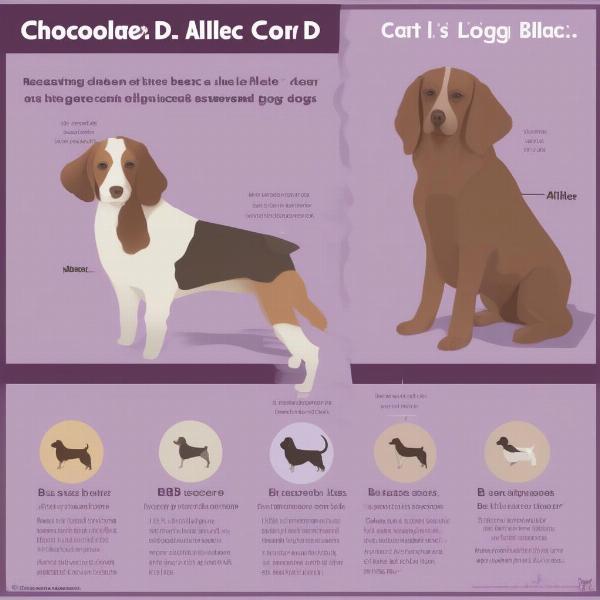The term “lilac dog” refers to a diluted chocolate or brown coat color in dogs, often described as a light grayish-brown or dove gray with a pinkish or lavender hue. This unique and increasingly popular coloration isn’t tied to a specific breed, but rather a genetic variation that can appear in several breeds. This article will explore the genetics behind the lilac color, the breeds where it’s commonly found, and the specific care considerations for lilac dogs.
The Genetics of the Lilac Coat
The lilac color is a result of a recessive gene called the “dilution gene,” specifically the “d” allele. This gene dilutes the pigment eumelanin, which is responsible for black and brown coloration. When a dog inherits two copies of this recessive gene (dd), it dilutes a chocolate or liver coat to the characteristic lilac shade. If a dog only inherits one copy (Dd), it will carry the gene but express the standard chocolate or brown coat color. Understanding this genetic basis is crucial for responsible breeding practices and helps predict the likelihood of lilac puppies in a litter.
 Lilac Dog Genetics
Lilac Dog Genetics
Breeds Where Lilac is Commonly Found
While theoretically possible in any breed carrying the chocolate/liver gene, the lilac color is more frequently observed in certain breeds. These include the American Pit Bull Terrier, French Bulldog, Staffordshire Bull Terrier, and the Neopolitan Mastiff. Within these breeds, the lilac color is often highly sought after, leading to increased demand and potentially higher prices.
Specific Care for Lilac Dogs
While the lilac coat color itself doesn’t dictate specific health concerns, some breeds where it’s common can be predisposed to certain conditions. For example, French Bulldogs are brachycephalic, meaning they have shortened snouts, which can lead to breathing difficulties. It’s crucial to research the specific health concerns related to the breed, rather than the color, and choose a reputable breeder who screens for these issues.
Color Dilution Alopecia (CDA)
One concern sometimes associated with the dilution gene, particularly in breeds like the Doberman Pinscher, is Color Dilution Alopecia (CDA). This condition can cause hair loss and skin problems. However, it’s important to note that not all lilac dogs develop CDA, and its prevalence varies among breeds. Regular veterinary checkups and a healthy diet can help manage any potential skin issues.
Grooming and Coat Maintenance
Lilac dogs require the same basic grooming as any other dog, with regular brushing to remove loose hair and prevent matting. The frequency of bathing depends on the breed and lifestyle, but over-bathing can strip the coat of its natural oils. High-quality dog shampoo and conditioner formulated for sensitive skin can help maintain a healthy and vibrant coat.
Finding a Reputable Lilac Dog Breeder
If you’re considering adding a lilac dog to your family, finding a responsible breeder is paramount. A reputable breeder prioritizes the health and temperament of their dogs, performs necessary health screenings, and provides proper socialization for puppies. They will also be knowledgeable about the genetics of the lilac color and be transparent about any potential health concerns related to the breed. Avoid breeders who solely focus on color and prioritize aesthetics over health.
Conclusion
The lilac dog, with its unique and beautiful coat color, is becoming increasingly popular. Understanding the genetics behind this color, the breeds where it’s found, and the potential health considerations associated with those breeds is essential for responsible ownership. By choosing a reputable breeder and providing proper care, you can ensure a long and happy life for your lilac companion.
FAQ
- Is the lilac color in dogs rare? It depends on the breed. While becoming more common, it’s still considered relatively rare in some breeds.
- Are lilac dogs more expensive? Due to their popularity, lilac dogs can sometimes be priced higher than other coat colors within the same breed.
- Do all lilac dogs have health problems? Not all lilac dogs have health problems, but certain breeds where the color is common may have breed-specific predispositions.
- What is CDA? CDA stands for Color Dilution Alopecia, a skin condition that can sometimes affect dogs with diluted coat colors, including lilac.
- How do I find a reputable breeder? Research breed-specific rescue organizations and breeder clubs for recommendations and guidance.
lilac city dog training spokane
ILM Dog is your trusted source for comprehensive information on dog breeds, health, training, nutrition, grooming, and more. We’re dedicated to providing expert advice and practical tips for dog owners worldwide. Whether you’re a seasoned dog owner or just starting your journey, ILM Dog is here to support you every step of the way. Contact us at [email protected] or +44 20-3965-8624 for expert guidance on all aspects of dog care.